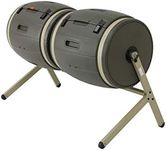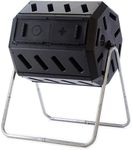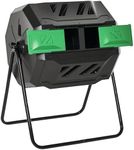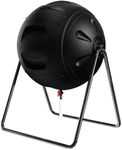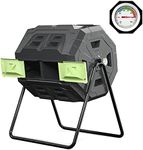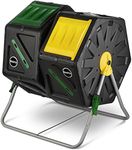Buying Guide for the Best Composting Tumblers
Choosing the right composting tumbler can make composting at home much easier and more efficient. Composting tumblers are designed to speed up the composting process by allowing you to easily mix and aerate your compost. When picking a tumbler, it's important to think about how much waste you generate, how much space you have, and how much effort you want to put into turning your compost. Understanding the key features will help you find a tumbler that fits your needs and lifestyle.CapacityCapacity refers to how much material the tumbler can hold, usually measured in gallons or liters. This is important because it determines how much compost you can make at one time. Small tumblers (under 40 gallons) are good for individuals or small households with limited kitchen and garden waste. Medium tumblers (40-80 gallons) suit average families or those with moderate garden waste. Large tumblers (over 80 gallons) are best for big families or avid gardeners who generate a lot of organic waste. To pick the right capacity, consider how much compostable material you produce each week and how often you want to empty the tumbler.
Aeration and Mixing MechanismAeration is how well the tumbler allows air to circulate through the compost, which is crucial for breaking down materials quickly and preventing bad smells. Tumblers use different mechanisms for mixing, such as internal fins or paddles, and some are easier to turn than others. Tumblers with good aeration and easy-to-use mixing handles make composting less work and help produce compost faster. If you want a low-effort experience, look for a tumbler with a smooth-turning mechanism and built-in aeration features.
Material and DurabilityThe material of the tumbler affects how long it will last and how well it holds up to weather. Most tumblers are made from plastic or metal. Plastic tumblers are lightweight and resistant to rust, but they can degrade in strong sunlight over time. Metal tumblers are sturdy and durable but may be heavier and can rust if not coated properly. If you plan to keep your tumbler outdoors year-round, choose one made from UV-resistant plastic or rust-resistant metal to ensure it lasts longer.
Number of ChambersSome composting tumblers have one chamber, while others have two or more. Single-chamber tumblers are simple and good for beginners, but you have to wait until the compost is finished before starting a new batch. Dual-chamber tumblers let you fill one side while the other side finishes composting, so you can have a continuous supply of compost. If you want a steady flow of compost or have a lot of waste, a dual-chamber model may be more convenient.
Ease of Use and PlacementEase of use includes how simple it is to load, turn, and empty the tumbler. Some models are higher off the ground, making it easier to place a wheelbarrow or bucket underneath for emptying. Others are lower and may be easier to fill. Consider where you will place the tumbler—make sure you have enough space and that the location gets some sun to help speed up composting. If you have limited mobility or strength, look for a tumbler that is easy to turn and access.
